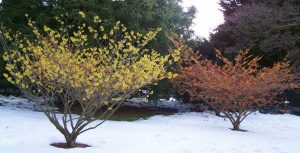By Jack MacRae
Witch Hazel might sound like a cousin of Samantha Stevens. But botanically, it is really an attractive understory shrub found in naturally wooded areas. Their attractive, rounded-oval form makes them popular around the globe. 
Illinois is home to the Virginia variety, Hamamelis virginiana. It can grow to 10-15 feet in our area and has roundish, toothed leaves.
Witch hazel is one of the last plants to bloom; which makes them easy to spot on your holiday post-dinner hikes to burn off the pumpkin pie. Their slightly fragrant, slender yellow flowers appear after their leaves have dropped. Pay close attention and you can see these flowers can open and close as the autumn temperatures fluctuate.
Blown Away!
When the flowers are finished, witch hazels produce hard, brown, 2 chambered, hairy seed capsules. The capsules require a year to mature and will still be present when the plant flowers next season. According to the great Illinois Naturalist Sue Post, witch hazel “is the only tree in the North American woods to have ripe fruit, flowers, and next year’s leaf buds all on the branch at the same time”. When the capsules have dried, they explode – blasting their seeds 25 feet away.
I was disappointed when I learned the plant has nothing to do with mysticism or the Wiccan religion. The name comes from an Olde  Middle English word Wyche, which translates to pliant or flexible.
Middle English word Wyche, which translates to pliant or flexible.
The pseudo-scientists of archaic Europe concluded the bendy, crooked branches of the shrub made good “divining” rods. That is, this plant had the ability to sense – and bend toward – subterranean water, a process then known as “water wyching”. The movement of divining rods is based on the same fundamental pseudoscientific principles of the Ouija board.
